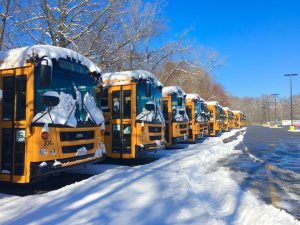Wellesley Public Schools won’t reduce bus fees next school year due to ‘budget constraints’
After reducing bus fees for three straight years to encourage more ridership, the Wellesley school system will keep the price at $300 next year for students living within 2 miles of their schools.
“The budget for next year had some pretty tight constraints, so we weren’t able to work that in,” said Niki Ofenloch, vice chair of the Wellesley School Committee.
School buses are free to ride for students up to grade 6 who live more than 2 miles from their schools. All students in grades 7 through 12 and those who live less than 2 miles from school must pay the fee.
The bus fee was $521 for the 2021-22 school year, but the district gradually reduced it over the next three years, lowering it this year to $300 per student, with a $700 family cap. By increasing ridership, the school system aims to help the town lower carbon emissions and time spent in traffic.
As fees have been reduced, more students are taking the bus. Paid ridership grew from 810 to 971 over the three years, said Sharon Gray, a spokesperson for Wellesley Public Schools. Gray cautioned that the district has not made a direct correlation between the fee reductions and the increase in ridership, however.
Bus ridership increased even as overall school enrollment declined over these three years. The district projects that enrollment will continue decreasing in the next two years, according to the recently approved budget.
 Although school bus fees have not been lowered for the 2025–26 school year, Ofenloch said the school system still has a strategy to get more students on the bus. The district’s five-year strategic plan, adopted in 2023, called for eliminating bus fees by the 2027–28 school year.
Although school bus fees have not been lowered for the 2025–26 school year, Ofenloch said the school system still has a strategy to get more students on the bus. The district’s five-year strategic plan, adopted in 2023, called for eliminating bus fees by the 2027–28 school year.
“It is still part of the district’s strategic plan to continue to reduce the bus fees,” Ofenloch said. “And I think the School Committee will, each year, as part of the budget process, consider that and determine the best possible path forward. [This year] there was not a change in strategy – it was just a tight budget constraint.”
Wellesley has three MBTA commuter rail stations and three MWRTA bus stops, but traffic congestion persists. Only 5% of Wellesley residents said they use public transit to get to work, while 49% drive alone, according to 2023 U.S. Census data.
Rachel Laufer pays the $300 bus fee for her daughter, a first-grader at Hunnewell Elementary School. She said cars on Washington Street are often “bumper to bumper.”
“Sometimes [traffic] in Wellesley is super stressful, just getting from point A to point B,” Laufer said. “You just get clogged up, and there’s just way too many cars.”
Finn Reilly, a sophomore at Wellesley High School, said he drives to school and often gets caught in traffic.
“Especially before school, there’s a ton of traffic,” he said. “You maybe move up five cars in one minute. It’s crazy. What would be a 5-10 minute drive takes like 20 minutes.”
Phyllis Theermann, a board member of Sustainable Wellesley, which advocates for local climate action, agreed that traffic congestion is a problem in town.
“We have a saying that, ‘You are not in traffic – you are traffic,’” Theermann wrote in an email.
Wellesley has a greenhouse gas emissions reduction goal to reach net-zero emissions by 2050. About 32% of Wellesley’s emissions came from transportation in 2023, according to the greenhouse gas emissions inventory from the Climate Action Committee.
“The more folks we get out of single-occupancy vehicles and into public transit, school buses, walking, biking, scooter and carpooling, the better,” Theermann wrote.
Brynn Franceschini, a sophomore at Wellesley High School, said she understands the environmental impact but isn’t sure how many high school students would take the bus rather than drive to school.
“A lot of people like [driving to school], but reducing carbon emissions is always important,” Franceschini said.
Laufer said she appreciates Hunnewell’s “Safe Routes to School Program,” which encourages “walking, biking, and rolling to school” in the warmer months, according to the school’s website.
She said her daughter, Olivia, loves the program.
“It’s all about getting outdoors,” Laufer said. “[The students] walk right on the Brook Path, and they give the kids keychains. It’s a really fun event. I love that they do that. That’s a great option, too, as opposed to taking the bus, but both would be great.”
Making things more accessible for families helps drive the goal of eliminating bus fees and increasing ridership, Ofenloch said.
“It just allows families to have another way for their children to get to school,” she said.
This story is part of a partnership between the Swellesley Report and the Boston University Department of Journalism.